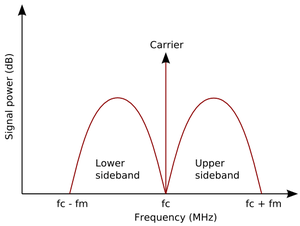The Difference Between AM and FM Radio Signals
06 Mar
Posted by RD Bentley as Amateur Radio, Science Sightings, Technology
Signal Carrier In AM and FM
Amplitude is defined as the distance between the tip crest of the wave to the rest position of the wave.
With Amplitude modulation, the amplitude of the carrier wave varies, while the frequency remains constant.
Frequency modulation is the encoding of information in a carrier wave by varying the instantaneous frequency of the wave.
FM has better noise (RFI) rejection than AM, making it the more popular choice for broadcasting.
Single Sideband Carrier
Most ham operators in the HF radio spectrum efficiently use Sideband, a band of frequencies higher than or lower than the carrier frequency, containing power as a result of the modulation process.
The signal components above the carrier frequency constitute the upper sideband (USB), and those below the carrier frequency constitute the lower sideband (LSB).
In SSB, the carrier is suppressed, significantly reducing the electrical power (by up to 12 dB) without affecting the information in the sideband.
Mobile And Wi-Fi Signals
What about Mobile phone and Wi-Fi signals? What is the engineering involved with these modes?
Image Credits: Wikipedia
Subscribe Now!
Featured Deal ➸
Social Button ➸
Categories
- 1
- 7Slots
- a16z generative ai
- Amateur Radio
- bauhutte-g.com
- blog
- Casino
- extension-autoroutes-non.ch
- Forex Trading
- Future Tech
- Geeky Tips
- Going Green
- Going Mobile
- kinbet-casino.at
- kinbet.at
- News
- Pin-Up AZ
- Pin-Up indir
- Pin-Up oyunu
- Pin-UP VCH
- Post
- Product Reviews
- ready_text
- Scanner Listening
- Science Sightings
- Sober living
- Technology
- Uncategorized
Archives
SQUIDBOARD
Academic Tech
Multimedia MegloMania
Tech Toolbox
- Acronis
- AN/GRC-9
- Apple Final Cut Pro
- Audacity
- Audacity VST Plug-ins
- BleachBit
- ClimateViewer 3D
- Cool Edit Pro 3.1
- CyberGhost
- Flickr
- FreeSCAN
- fring
- Fruper
- FTA Lists
- GPS Calculator
- GPS Converter
- HAMSOFT
- HF Antennas
- inSSIDer
- Levelator
- MaxMind
- Microphone Cables
- Morse Code Chart
- Old Version
- Pendriveapps.com
- PortableApps.com
- Privacy Badger
- PulseAudio
- Rowetel
- ShopJimmy
- Teleprompter Software
- TV Listings
- UNetbootin
- Voicemeeter Banana
- Winlink


RSS feed for comments on this post · TrackBack URI
Leave a reply